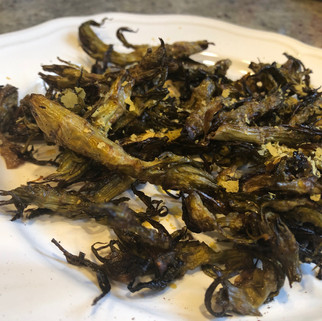It’s a Knotty Problem: Japanese Knotweed
- Kathleen

- Apr 24, 2020
- 3 min read
April 25, 2020
In my house, when I yell “Crisps!”, everyone comes on the run to get some. The delight in question? Brussels Sprouts.
Yes, Brussels Sprouts, that much-maligned vegetable. Boil them, and you’ve got a potful of smelly spheres and a houseful of unhappy campers. But roast them (or any other Brassica, such as cabbage or cauliflower), and you turn a downer into a delicacy.
There’s a lesson here about Knotweed, if you’re willing to wait for it.

As the name suggests, Japanese Knotweed is originally from Asia. Landscapers started using it in America for its ability to prevent erosion and its capacity to grow everywhere. Now, it is an invasive non-native that is taking over fields, woods, and roadsides throughout New England. It's almost impossible to kill or contain--so you are doing your civic duty to harvest and eat it!
In years past, I plucked just the young leaves and buds, which make a delightful and super healthy* addition to a spring salad. Because Knotweed is such a troublesome invasive, this year I was determined to do more, and spent about a half hour snapping off young shoots, 6” -8”. (If you can’t snap them off easily, they’re too old—keep picking the new leaves for your salad all summer long.)
So now I’ve got pounds of Knotweed taking up space in my fridge. In case you hadn’t realized it yet, I was raised believing that wasting food is a mortal sin right up there with coveting thy neighbor’s wife and worshiping false idols.

Knotweed can be used as a substitute for rhubarb-they taste and work almost exactly the same. I decided to cook my knotweed down into a compote I could use in place of rhubarb.
To approximately two pounds of Knotweed I added a cup of sugar, 1/8 cup lemon juice, and 1/4 cup white wine. Add more of anything, to taste.
Here’s the “knotty problem.” Being lazy, I boiled the big long stalks all at once in one giant pot and ended up with a tasty, colorful compote that was unfortunately stringy. The strings weren’t fibrous-- you couldn’t even feel them in your mouth--but presentation-wise—"Meh.” If I had chopped the stalks like rhubarb, the strings would have been a non-issue and you wouldn’t even have known it wasn’t rhubarb.
So, now, how to use this compote? First up: Pie. To complement the Knotweed’s slightly more earthy flavor, I decided to incorporate a cheese /custard base. Beginning with this recipe https://bakingbites.com/2017/03/lemon-blueberry-ricotta-pie/ I adapted. To avoid some of the sugar, I left off the crumble topping. Rather than layering the ricotta and the Knotweed puree, I marbled them as you might a chocolate swirl cheesecake (if only!). There were some blueberries in the fridge coming up on their expiration date, so I tossed them in too—and they were a great addition.

Next up: It was time to make some more Dock flour banana bread. The recipe I was using suggested you could substitute a cup of applesauce. What is similar to applesauce in flavor and water content? Knotweed purée, of course! So I used up a cup that way.
I had another recipe incorporating Knotweed into bread, so used more of the purée that way, and added walnuts and golden raisins. The bread was very heavy and dense--kind of like a Christmas fruitcake--but delicious for breakfast.
Finally I was left with a bunch of Knotweed tips and spears. Knotweed’s lemony flavor is great, and were it my only option for greens, I’d be grateful. But there are so many other lovely spring edibles coming in right now. How do I use up the Knotweed shoots taking up space in my refrigerator?
If it worked for Brussels Sprouts, surely it should work for Knotweed!
And indeed it did. Raw Knotweed has a somewhat slimy texture like okra (politely called “mucilaginous.”) Roasting/broiling the greens under high heat, with a little olive oil and salt and pepper until they were fairly charred, really helped offset the lemony/ sliminess with crispness and “umami-ness.” Serve them right away out of the oven though—this recipe only remains “restaurant quality” for a few minutes.
“Crisps!!” Let’s see if your family comes a’ runnin.’
*Japanese Knotweed provides an excellent source of Vitamins A and C, as well as potassium, phosphorus, zinc, and manganese. It’s a source of resveratrol, the substance in red wine that reduces bad cholesterol and lowers the risk of heart attacks. It’s been shown to be effective in treating Lyme disease. As an anti-inflammatory, it helps the immune system to combat infections and relieves the symptoms of arthritis.
























Comments